List of dinosaur genera

This list of dinosaurs is a comprehensive listing of all genera that have ever been included in the superorder Dinosauria, excluding class Aves (birds, both living and those known only from fossils) and purely vernacular terms. The list includes all commonly accepted genera, but also genera that are now considered invalid, doubtful (nomen dubium), or were not formally published (nomen nudum), as well as junior synonyms of more established names, and genera that are no longer considered dinosaurs. Many listed names have been reclassified as everything from birds to crocodilians to petrified wood. The list contains 1475 names, of which approximately 1146 are considered either valid dinosaur genera or nomina dubia.
Scope and terminology
There is no official, canonical list of dinosaur genera. The closest is the Dinosaur Genera List, compiled by biological nomenclature expert George Olshevsky, which was first published online in 1995 and is regularly updated. The most authoritative general source in the field is the second (2004) edition of The Dinosauria. The vast majority of citations are based on Olshevsky's list, and all subjective determinations (such as junior synonymy or non-dinosaurian status) are based on The Dinosauria, except where they conflict with primary literature. These exceptions are noted.
Naming conventions and terminology follow the International Code of Zoological Nomenclature. Technical terms used include:
- Junior synonym: A name which describes the same taxon as a previously published name. If two or more genera are formally designated and the type specimens are later assigned to the same genus, the first to be published (in chronological order) is the senior synonym, and all other instances are junior synonyms. Senior synonyms are generally used, except by special decision of the ICZN (see Tyrannosaurus), but junior synonyms cannot be used again, even if deprecated. Junior synonymy is often subjective, unless the genera described were both based on the same type specimen.
- Nomen nudum (Latin for "naked name"): A name that has appeared in print but has not yet been formally published by the standards of the ICZN. Nomina nuda (the plural form) are invalid, and are therefore not italicized as a proper generic name would be. If the name is later formally published, that name is no longer a nomen nudum and will be italicized on this list. Often, the formally published name will differ from any nomina nuda that describe the same specimen.
- Nomen oblitum (Latin for "forgotten name"): A name that has not been used in the scientific community for more than fifty years after its original proposal.
- Preoccupied name: A name that is formally published, but which has already been used for another taxon. This second use is invalid (as are all subsequent uses) and the name must be replaced. Preoccupied names are not valid generic names.
- Nomen dubium (Latin for "dubious name"): A name describing a fossil with no unique diagnostic features. As this can be an extremely subjective and controversial designation (see Hadrosaurus), this term is not used on this list.
A
| Contents: | A B C D E F G H I J K L M N O P Q R S T U V W X Y Z – See also |
|---|

- Aachenosaurus – a piece of petrified wood
- Aardonyx
- "Abdallahsaurus" – nomen nudum, probably Giraffatitan
- Abelisaurus
- Abrictosaurus
- Abrosaurus
- Abydosaurus
- Acanthopholis
- Achelousaurus
- Acheroraptor
- Achillesaurus
- Achillobator
- Acristavus
- Acrocanthosaurus
- Acrotholus
- Actiosaurus – a choristoderan
- Adamantisaurus
- Adasaurus
- Adelolophus
- Adeopapposaurus
- Aegyptosaurus
- Aeolosaurus
- Aepisaurus
- Aerosteon
- Aetonyx – possible junior synonym of Massospondylus
- Afrovenator
- Agathaumas
- Aggiosaurus – a metriorhynchid crocodilian
- Agilisaurus
- Agnosphitys
- Agrosaurus – probably a junior synonym of Thecodontosaurus
- Agujaceratops
- Agustinia
- Ahshislepelta
- Ajancingenia
- Ajkaceratops
- Alamosaurus
- Alaskacephale
- Albalophosaurus
- Albertaceratops
- Albertadromeus
- Albertonykus
- Albertosaurus
- Albinykus[1]
- Albisaurus – a non-dinosaurian reptile
- Alectrosaurus
- Aletopelta
- Algoasaurus
- Alioramus
- Aliwalia – junior synonym of Eucnemesaurus

- Allosaurus
- Alnashetri
- Alocodon
- Altirhinus
- Altispinax
- Alvarezsaurus
- Alwalkeria
- Alxasaurus
- Amargasaurus
- Amargastegos
- Amargatitanis
- Amazonsaurus
- Ammosaurus
- Ampelosaurus
- Amphicoelias
- "Amphicoelicaudia" – nomen nudum; possibly Huabeisaurus
- "Amphisaurus" – preoccupied name, now known as Anchisaurus
- Amtocephale
- Amtosaurus – possibly Talarurus
- Amurosaurus
- Amygdalodon
- Anabisetia
- Anasazisaurus
- Anatosaurus – junior synonym of Edmontosaurus
- Anatotitan – junior synonym of Edmontosaurus
- Anchiceratops
- Anchiornis
- Anchisaurus
- Andesaurus
- Andhrasaurus
- Angaturama – probable junior synonym of Irritator
- "Angloposeidon"[2][3] – nomen nudum
- Angolatitan
- Angulomastacator
- Aniksosaurus
- Animantarx
- Ankistrodon – a proterosuchid archosauriform
- Ankylosaurus
- Anodontosaurus
- Anoplosaurus
- Anserimimus
- Antarctopelta
- Antarctosaurus
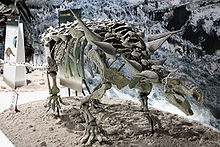
- Antetonitrus
- Anthodon – a pareiasaur
- Antrodemus – possibly a junior synonym of Allosaurus
- Anzu
- Aorun
- Apatodon – possibly a junior synonym of Allosaurus
- Apatosaurus
- Appalachiosaurus
- Aquilops
- Aragosaurus
- Aralosaurus
- "Araucanoraptor" – nomen nudum; Neuquenraptor
- Archaeoceratops
- Archaeodontosaurus
- Archaeopteryx – earliest known bird
- "Archaeoraptor" – now known as the bird Yanornis and the dromaeosaur Microraptor
- Archaeornis – junior synonym of the bird Archaeopteryx
- Archaeornithoides
- Archaeornithomimus
- Arcovenator[4]
- Arctosaurus – some sort of non-dinosaurian reptile
- Arcusaurus
- Arenysaurus
- Argentinosaurus
- Argyrosaurus
- Aristosaurus – junior synonym of Massospondylus
- Aristosuchus
- Arizonasaurus – a rauisuchian
- "Arkansaurus" – nomen nudum
- Arkharavia
- Arrhinoceratops
- Arstanosaurus
- Asiaceratops
- Asiamericana – a fish
- Asiatosaurus
- Astrodon
- Astrodonius – junior synonym of Astrodon
- Astrodontaurus – junior synonym of Astrodon
- Astrophocaudia
- Asylosaurus
- Atacamatitan
- Atlantosaurus
- Atlasaurus
- Atlascopcosaurus
- Atrociraptor
- Atsinganosaurus
- Aublysodon
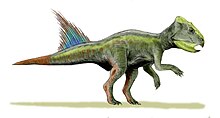
- Aucasaurus
- "Augustia" – preoccupied name, now known as Agustinia
- Augustynolophus
- Auroraceratops
- Aurornis
- Australodocus
- Australovenator
- Austrocheirus
- Austroraptor
- Austrosaurus
- Avaceratops
- "Avalonia" – preoccupied name, now known as Avalonianus
- Avalonianus – a non-dinosaurian archosaur
- Aviatyrannis
- Avimimus
- Avipes – probably a non-dinosaurian dinosauromorph
- Azendohsaurus – a non-dinosaurian archosauromorph
B
| Contents: | A B C D E F G H I J K L M N O P Q R S T U V W X Y Z – See also |
|---|
- Bactrosaurus
- Bagaceratops
- Bagaraatan
- Bahariasaurus
- Bainoceratops
- "Bakesaurus" – nomen nudum
- Balaur
- Balochisaurus
- Bambiraptor
- Banji
- Baotianmansaurus
- Barapasaurus
- Barilium
- Barosaurus
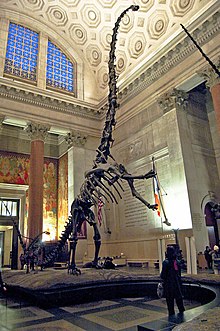
- Barrosasaurus
- Barsboldia
- Baryonyx
- "Bashunosaurus" – nomen nudum
- Basutodon – a non-dinosaurian archosaur
- Bathygnathus – a pelycosaur
- Batyrosaurus[5]
- Baurutitan
- "Bayosaurus" – nomen nudum
- Becklespinax
- "Beelemodon" – nomen nudum
- Beipiaosaurus
- Beishanlong
- Bellusaurus
- Belodon – a phytosaur
- Berberosaurus
- Betasuchus
- Bicentenaria
- Bienosaurus
- Bihariosaurus
- "Bilbeyhallorum" – nomen nudum; Cedarpelta
- Bissektipelta
- Bistahieversor
- "Blancocerosaurus" – nomen nudum, probably Giraffatitan
- Blasisaurus
- Blikanasaurus
- Bolong
- Bonapartenykus
- Bonatitan
- Bonitasaura
- Borealosaurus
- Boreonykus
- Borogovia
- Bothriospondylus
- Brachiosaurus
- Brachyceratops
- Brachylophosaurus
- Brachypodosaurus
- Brachyrophus – junior synonym of Camptosaurus
- Brachytaenius – a metriorhynchid; junior objective synonym of Dakosaurus
- Brachytrachelopan
- Bradycneme
- Brasileosaurus – a non-dinosaurian archosaur
- Brasilotitan
- Bravoceratops
- Breviceratops
- Brohisaurus
- Brontomerus
- "Brontoraptor" – nomen nudum
- Brontosaurus
- Bruhathkayosaurus
- Bugenasaura – junior synonym of Thescelosaurus
- Buitreraptor
- "Byranjaffia" – nomen nudum; Byronosaurus
- Byronosaurus
C
| Contents: | A B C D E F G H I J K L M N O P Q R S T U V W X Y Z – See also |
|---|

- Caenagnathasia
- Caenagnathus
- Calamosaurus
- Calamospondylus Fox, 1866
- "Calamospondylus" Lydekker, 1889 – preoccupied name, now known as Calamosaurus
- Callovosaurus
- Camarasaurus
- Camarillasaurus
- Camelotia
- Camposaurus
- "Camptonotus" – preoccupied name, now known as Camptosaurus
- Camptosaurus
- "Campylodon" – preoccupied name, now known as Campylodoniscus
- Campylodoniscus
- Canardia
- "Capitalsaurus" – nomen nudum
- Carcharodontosaurus
- Cardiodon
- Carnotaurus
- Caseosaurus
- Cathartesaura
- Cathetosaurus
- Caudipteryx
- Caudocoelus – junior synonym of Teinurosaurus
- Caulodon – junior synonym of Camarasaurus
- Cedarosaurus
- Cedarpelta
- Cedrorestes
- Centemodon – a phytosaur
- Centrosaurus
- Cerasinops
- Ceratonykus
- Ceratops
- Ceratosaurus
- Cetiosauriscus
- Cetiosaurus
- Changchunsaurus
- "Changdusaurus" – nomen nudum
- Changyuraptor
- Chaoyangsaurus
- Charonosaurus
- Chasmosaurus
- Chassternbergia – junior synonym of Edmontonia
- Chebsaurus
- Cheneosaurus – junior synonym of Hypacrosaurus
- Chialingosaurus
- Chiayusaurus
- Chienkosaurus – a chimera of crocodyliform and theropod (Szechuanosaurus) remains
- "Chihuahuasaurus" – nomen nudum; Sonorasaurus
- Chilantaisaurus
- Chilesaurus
- Chindesaurus
- Chingkankousaurus

- Chinshakiangosaurus
- Chirostenotes
- Chondrosteosaurus
- Chromogisaurus
- Chuandongocoelurus
- Chuanjiesaurus
- Chuanqilong
- Chubutisaurus
- Chungkingosaurus
- Chuxiongosaurus
- "Cinizasaurus" – nomen nudum
- Cionodon
- Citipati
- Cladeiodon – a non-dinosaurian rauisuchian (Teratosaurus)
- Claorhynchus – possibly Triceratops
- Claosaurus
- Clarencea – a sphenosuchian (Sphenosuchus)
- Clasmodosaurus
- Clepsysaurus – a phytosaur
- Coahuilaceratops
- Coelophysis
- "Coelosaurus" – preoccupied name, in need of a replacement name
- Coeluroides
- Coelurosauravus – an avicephalan diapsid
- Coelurus
- Colepiocephale
- "Coloradia" – preoccupied name, now known as Coloradisaurus
- Coloradisaurus
- "Colossosaurus" – nomen nudum; Pelorosaurus
- Comahuesaurus
- "Comanchesaurus" – nomen nudum
- Compsognathus
- Compsosuchus
- Concavenator
- Conchoraptor
- Condorraptor
- Coronosaurus
- Corythosaurus
- Craspedodon
- Crataeomus – junior synonym of Struthiosaurus
- Craterosaurus
- Creosaurus – junior synonym of Allosaurus
- Crichtonpelta
- Crichtonsaurus
- Cristatusaurus
- Crosbysaurus – a non-dinosaurian archosauriform
- Cruxicheiros
- Cryolophosaurus
- Cryptodraco – junior synonym (unneeded replacement name) of Cryptosaurus
- "Cryptoraptor" – nomen nudum
- Cryptosaurus
- Cryptovolans – junior synonym of Microraptor
- Cumnoria
D
| Contents: | A B C D E F G H I J K L M N O P Q R S T U V W X Y Z – See also |
|---|
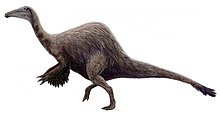
- Daanosaurus
- Dacentrurus
- "Dachongosaurus" – nomen nudum
- Daemonosaurus
- Dahalokely
- Dakosaurus – a metriorhynchid crocodilian
- Dakotadon
- Dakotaraptor
- "Damalasaurus" – nomen nudum
- Dandakosaurus
- Danubiosaurus – junior synonym of Struthiosaurus
- "Daptosaurus" – nomen nudum; early manuscript name for Deinonychus
- Darwinsaurus[6]
- Dashanpusaurus
- Daspletosaurus
- Dasygnathoides – a non-dinosaurian archosaur, junior synonym of Ornithosuchus
- "Dasygnathus" – preoccupied name, now known as Dasygnathoides
- Datanglong
- Datonglong
- Datousaurus
- Daurosaurus – synonym of Kulindadromeus
- Daxiatitan
- Deinocheirus
- Deinodon – possibly Gorgosaurus
- Deinonychus
- Delapparentia[7]
- Deltadromeus
- Demandasaurus
- Denversaurus
- Deuterosaurus – a therapsid
- Diabloceratops
- Diamantinasaurus
- Dianchungosaurus – a crocodilian
- "Diceratops" – preoccupied name, now known as Nedoceratops
- Diceratus – junior synonym of Nedoceratops
- Diclonius
- Dicraeosaurus
- Didanodon – possibly a junior synonym of Lambeosaurus
- Dilong
- Dilophosaurus
- Dimodosaurus – junior synonym of Plateosaurus
- Dinheirosaurus – probable junior synonym of Supersaurus
- Dinodocus
- "Dinosaurus" – preoccupied name, now a junior synonym of Plateosaurus
- Dinotyrannus – junior synonym of Tyrannosaurus
- Diplodocus
- Diplotomodon
- Diracodon – junior synonym of Stegosaurus
- Dolichosuchus
- Dollodon – junior synonym of Mantellisaurus
- "Domeykosaurus" – nomen nudum
- Dongbeititan
- Dongyangopelta
- Dongyangosaurus
- Doratodon – a crocodilian
- Doryphorosaurus – junior synonym (unneeded replacement name) of Kentrosaurus
- Draconyx
- Dracopelta
- Dracoraptor

- Dracorex – possibly a juvenile Pachycephalosaurus
- Dracovenator
- Dravidosaurus – a plesiosaurian
- Dreadnoughtus
- Drinker
- Dromaeosauroides
- Dromaeosaurus
- Dromiceiomimus – junior synonym of Ornithomimus
- Dromicosaurus – junior synonym of Massospondylus
- Drusilasaura
- Dryosaurus
- Dryptosauroides
- Dryptosaurus
- Dubreuillosaurus
- Duriatitan
- Duriavenator
- Dynamosaurus – junior synonym of Tyrannosaurus
- Dyoplosaurus
- Dysalotosaurus
- Dysganus
- Dyslocosaurus
- Dystrophaeus
- Dystylosaurus – junior synonym of Supersaurus
E
| Contents: | A B C D E F G H I J K L M N O P Q R S T U V W X Y Z – See also |
|---|
- Echinodon
- Edmarka – junior synonym of Torvosaurus
- Edmontonia
- Edmontosaurus
- Efraasia
- Einiosaurus
- Ekrixinatosaurus
- Elachistosuchus – a rhynchocephalian
- Elaltitan
- Elaphrosaurus
- Elmisaurus
- Elopteryx
- Elosaurus – junior synonym of Brontosaurus
- Elrhazosaurus
- "Elvisaurus" – nomen nudum; Cryolophosaurus
- Emausaurus
- Embasaurus
- Enigmosaurus
- Eoabelisaurus
- Eobrontosaurus – junior synonym of Brontosaurus
- Eocarcharia
- Eoceratops – junior synonym of Chasmosaurus
- Eocursor
- Eodromaeus
- "Eohadrosaurus" – nomen nudum; Eolambia
- Eolambia
- Eomamenchisaurus
- Eoplophysis
- Eoraptor
- Eosinopteryx
- Eotrachodon
- Eotriceratops
- Eotyrannus
- Eousdryosaurus
- Epachthosaurus
- Epanterias – may be Allosaurus

- "Ephoenosaurus" – nomen nudum; Machimosaurus (a crocodilian)
- Epicampodon – a proterosuchid archosauriform
- Epichirostenotes
- Epidendrosaurus – synonym of Scansoriopteryx
- Epidexipteryx
- Equijubus
- Erectopus
- Erketu
- Erliansaurus
- Erlikosaurus
- Eshanosaurus
- "Euacanthus" – nomen nudum; junior synonym of Polacanthus
- Eucamerotus
- Eucentrosaurus – junior synonym (unneeded replacement name) of Centrosaurus
- Eucercosaurus
- Eucnemesaurus
- Eucoelophysis – a silesaurid
- "Eugongbusaurus" – nomen nudum
- Euhelopus
- Euoplocephalus
- Eupodosaurus – a nothosaur synonymous with Lariosaurus
- "Eureodon" – nomen nudum; Tenontosaurus
- Eurolimnornis – a pterosaur
- Euronychodon
- Europasaurus
- Europelta
- Euskelosaurus
- Eustreptospondylus
F
| Contents: | A B C D E F G H I J K L M N O P Q R S T U V W X Y Z – See also |
|---|
- Fabrosaurus – possibly Lesothosaurus
- Falcarius
- "Fenestrosaurus" – nomen nudum; Oviraptor
- Ferganasaurus
- Ferganastegos
- Ferganocephale
- Fosterovenator
- Frenguellisaurus – junior synonym of Herrerasaurus
- Fruitadens

- Fukuiraptor
- Fukuisaurus
- Fukuititan
- Fulengia
- Fulgurotherium
- "Fusinasus" – nomen nudum; Eotyrannus
- Fusuisaurus
- "Futabasaurus" – nomen nudum; not to be confused with the formally named plesiosaur Futabasaurus
- Futalognkosaurus
G
| Contents: | A B C D E F G H I J K L M N O P Q R S T U V W X Y Z – See also |
|---|
- "Gadolosaurus" – nomen nudum
- Galeamopus
- Galesaurus – a therapsid
- Gallimimus
- Galtonia – a pseudosuchian; possibly a junior synonym of Revueltosaurus
- Galveosaurus
- Galvesaurus – junior synonym of Galveosaurus
- Gannansaurus
- "Gansutitan" - nomen nudum; Daxiatitan
- Ganzhousaurus
- Gargoyleosaurus
- Garudimimus
- Gasosaurus
- Gasparinisaura
- Gastonia
- "Gavinosaurus" – nomen nudum; Eotyrannus
- Geminiraptor
- Genusaurus
- Genyodectes
- Geranosaurus
- Gideonmantellia
- Giganotosaurus
- Gigantoraptor
- Gigantosaurus Seeley, 1869
- "Gigantosaurus" E. Fraas, 1908 – preoccupied name, now known as Tornieria
- Gigantoscelus – junior synonym of Euskelosaurus
- Gigantspinosaurus
- Gilmoreosaurus
- "Ginnareemimus" – nomen nudum; Kinnareemimus
- Giraffatitan
- Glacialisaurus
- Glishades
- Glyptodontopelta
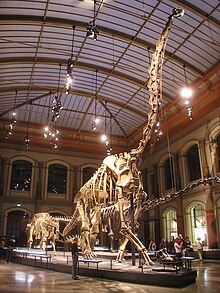
- Gobiceratops
- Gobisaurus
- Gobititan
- Gobivenator
- "Godzillasaurus" – nomen nudum; Gojirasaurus
- Gojirasaurus
- Gondwanatitan
- Gongbusaurus
- Gongpoquansaurus
- Gongxianosaurus
- Gorgosaurus
- Goyocephale
- Graciliceratops
- Graciliraptor
- Gracilisuchus – a non-dinosaurian archosaur
- Gravitholus
- Gresslyosaurus – junior synonym of Plateosaurus
- Griphornis – junior synonym of the bird Archaeopteryx
- Griphosaurus – junior synonym of the bird Archaeopteryx
- Gryphoceratops
- Gryponyx
- Gryposaurus
- Guaibasaurus
- Guanlong
- Gwyneddosaurus – a tanystrophid
- Gyposaurus – junior synonym of Massospondylus
H
| Contents: | A B C D E F G H I J K L M N O P Q R S T U V W X Y Z – See also |
|---|
- "Hadrosauravus" – nomen nudum; junior synonym of Gryposaurus
- Hadrosaurus
- Haestasaurus
- Hagryphus
- Hallopus – a crocodilian
- Halticosaurus
- Hanssuesia
- "Hanwulosaurus" – nomen nudum
- Haplocanthosaurus
- "Haplocanthus" – preoccupied name, now known as Haplocanthosaurus
- Haplocheirus
- Harpymimus
- Haya
- Hecatasaurus – junior synonym of Telmatosaurus
- "Heilongjiangosaurus" – nomen nudum
- Heishansaurus – junior synonym of Pinacosaurus
- Helioceratops
- "Helopus" – preoccupied name, now known as Euhelopus
- Heptasteornis
- Herbstosaurus – a pterosaur
- Herrerasaurus
- Hesperonychus
- Hesperosaurus
- Heterodontosaurus
- Heterosaurus - junior synonym of Mantellisaurus
- Hexing[8]
- Hexinlusaurus
- Heyuannia

- Hierosaurus
- Hippodraco
- "Hironosaurus" – nomen nudum
- "Hisanohamasaurus" – nomen nudum
- Histriasaurus
- Homalocephale
- "Honghesaurus" – nomen nudum; Yandusaurus
- Hongshanosaurus – junior synonym of Psittacosaurus
- Hoplitosaurus
- Hoplosaurus – junior synonym of Struthiosaurus
- Horshamosaurus
- Hortalotarsus – junior synonym of Massospondylus
- Huabeisaurus
- Hualianceratops
- Huanansaurus
- Huanghetitan
- Huangshanlong
- Huaxiagnathus
- Huaxiaosaurus - possible junior synonym of Shantungosaurus
- "Huaxiasaurus" – nomen nudum; Huaxiagnathus
- Huayangosaurus
- Hudiesaurus
- Huehuecanauhtlus
- Hulsanpes – possibly a bird
- Hungarosaurus
- Huxleysaurus[6]
- Hylaeosaurus
- Hylosaurus – junior synonym of Hylaeosaurus
- Hypacrosaurus
- Hypselorhachis – a ctenosauriscid
- Hypselosaurus
- Hypselospinus
- Hypsibema
- Hypsilophodon
- Hypsirophus – junior synonym of Stegosaurus
I
| Contents: | A B C D E F G H I J K L M N O P Q R S T U V W X Y Z – See also |
|---|
- "Ichabodcraniosaurus" – nomen nudum; probably Velociraptor
- Ichthyovenator
- Ignavusaurus
- Iguanacolossus
- Iguanodon
- "Iguanoides" – nomen nudum; Iguanodon
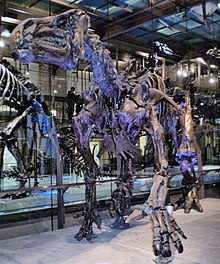
- "Iguanosaurus" – nomen nudum; Iguanodon
- Iliosuchus
- Ilokelesia
- Incisivosaurus
- Indosaurus
- Indosuchus
- "Ingenia" – preoccupied name, now known as Ajancingenia
- Inosaurus
- Irritator
- Isanosaurus
- Ischioceratops
- Ischisaurus – junior synonym of Herrerasaurus
- "Ischyrosaurus" – preoccupied name, has not yet been renamed
- Isisaurus
- "Issasaurus" – nomen nudum; Dicraeosaurus
- Itemirus
- Iuticosaurus
J
| Contents: | A B C D E F G H I J K L M N O P Q R S T U V W X Y Z – See also |
|---|
- Jainosaurus
- Jaklapallisaurus
- Janenschia
- Jaxartosaurus
- Jeholosaurus
- Jenghizkhan – junior synonym of Tarbosaurus
- "Jensenosaurus" – nomen nudum; Supersaurus
- Jeyawati
- Jianchangosaurus
- "Jiangjunmiaosaurus" – nomen nudum; Monolophosaurus
- Jiangjunosaurus
- Jiangshanosaurus

- Jiangxisaurus
- Jinfengopteryx
- Jingshanosaurus
- Jintasaurus
- Jinzhousaurus
- Jiutaisaurus
- Jobaria
- Jubbulpuria
- Judiceratops
- Jurapteryx – junior synonym of the bird Archaeopteryx
- "Jurassosaurus" – nomen nudum; Tianchisaurus
- Juratyrant
- Juravenator
K
| Contents: | A B C D E F G H I J K L M N O P Q R S T U V W X Y Z – See also |
|---|
- Kaatedocus
- "Kagasaurus" – nomen nudum
- Kaijiangosaurus
- Kakuru
- Kangnasaurus
- Karongasaurus
- Katepensaurus
- "Katsuyamasaurus" – nomen nudum; possible junior synonym of Fukuiraptor
- Kayentavenator
- Kazaklambia
- Kelmayisaurus
- Kemkemia - a crocodyliform
- Kentrosaurus
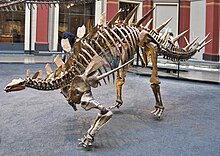
- Kentrurosaurus – junior synonym (unneeded replacement name) of Kentrosaurus
- Kerberosaurus
- Khaan
- Khetranisaurus
- Kileskus
- Kinnareemimus
- "Kitadanisaurus" – nomen nudum; Fukuiraptor
- "Kittysaurus" – nomen nudum; Eotyrannus
- Klamelisaurus - possible junior synonym of Bellusaurus
- Kol
- Koparion
- Koreaceratops
- Koreanosaurus Huh et al., 2011
- "Koreanosaurus" Kim, 1979 – nomen nudum; name later used formally for a genus of ornithopod
- Koshisaurus
- Kosmoceratops
- Kotasaurus
- Koutalisaurus
- Kritosaurus
- Kryptops
- Krzyzanowskisaurus – probably a pseudosuchian (?Revueltosaurus)
- Kukufeldia
- Kulceratops
- Kulindadromeus
- Kulindapteryx – synonym of Kulindadromeus
- Kunbarrasaurus
- Kundurosaurus
- Kunmingosaurus – may be a nomen nudum
- Kuszholia – probably a bird
L
| Contents: | A B C D E F G H I J K L M N O P Q R S T U V W X Y Z – See also |
|---|
- Labocania
- Labrosaurus – junior synonym of Allosaurus
- "Laelaps" – preoccupied name, now known as Dryptosaurus
- Laevisuchus
- Lagerpeton – a non-dinosaurian dinosauromorph
- Lagosuchus – a non-dinosaurian dinosauromorph
- Lamaceratops - possible junior synonym of Bagaceratops
- Lambeosaurus
- Lametasaurus
- Lamplughsaura
- Lanasaurus – junior synonym of Lycorhinus
- "Lancangosaurus" – variant spelling of "Lancanjiangosaurus"
- "Lancanjiangosaurus" – nomen nudum
- Lanzhousaurus
- Laosaurus
- Lapampasaurus
- Laplatasaurus
- Lapparentosaurus
- Laquintasaura
- Latirhinus
- Leaellynasaura
- Leinkupal
- Leipsanosaurus – junior synonym of Struthiosaurus
- "Lengosaurus" – nomen nudum; Eotyrannus
- Leonerasaurus
- Lepidocheirosaurus — junior synonym of Kulindadromeus
- Lepidus
- Leptoceratops
- Leptorhynchos
- Leptospondylus – junior synonym of Massospondylus
- Leshansaurus
- Lesothosaurus
- Lessemsaurus
- Levnesovia
- Lewisuchus – a non-dinosaurian dinosauromorph
- Lexovisaurus

- Leyesaurus[9]
- Liaoceratops
- Liaoningosaurus
- Libycosaurus – an anthracothere mammal
- Ligabueino
- Ligabuesaurus
- "Ligomasaurus" – nomen nudum, probably Giraffatitan
- "Likhoelesaurus" – nomen nudum; possibly non-dinosaurian
- Liliensternus
- Limaysaurus
- "Limnornis" – preoccupied name, now known as Palaeocursornis ( a pterosaur)
- "Limnosaurus" – preoccupied name, now known as Telmatosaurus
- Limusaurus
- Linhenykus
- Linheraptor
- Linhevenator
- Lirainosaurus
- Lisboasaurus – a crocodilian
- Liubangosaurus
- Loncosaurus
- Longisquama – some sort of non-dinosaurian reptile
- Longosaurus – junior synonym of Coelophysis
- Lophorhothon
- Lophostropheus
- Loricatosaurus
- Loricosaurus
- Losillasaurus
- Lourinhanosaurus
- Lourinhasaurus
- Luanchuanraptor
- "Luanpingosaurus" – nomen nudum; Psittacosaurus
- Lucianosaurus – a non-dinosaurian archosauriform
- Lufengosaurus
- Lukousaurus - possibly a crurotarsan
- Luoyanggia
- Lurdusaurus
- Lusitanosaurus
- Lusotitan
- Lycorhinus
- Lythronax
M
| Contents: | A B C D E F G H I J K L M N O P Q R S T U V W X Y Z – See also |
|---|
- Macelognathus – a sphenosuchian crocodilian
- Machairasaurus
- Macrodontophion - a member of Lophotrochozoa
- Macrogryphosaurus
- Macrophalangia – junior synonym of Chirostenotes
- "Macroscelosaurus" – nomen nudum; probable junior synonym of Tanystropheus
- Macrurosaurus
- "Madsenius" – nomen nudum
- Magnapaulia[10]
- Magnirostris
- Magnosaurus
- "Magulodon" – nomen nudum
- Magyarosaurus
- Mahakala
- Maiasaura
- Majungasaurus
- Majungatholus – junior synonym of Majungasaurus
- Malarguesaurus
- Malawisaurus
- Maleevosaurus – junior synonym of Tarbosaurus
- Maleevus

- Mamenchisaurus
- Manidens
- Mandschurosaurus
- Manospondylus – synonym of Tyrannosaurus
- Mantellisaurus
- Mantellodon[6] - possible junior synonym of Mantellisaurus
- Mapusaurus
- Marasuchus – a non-dinosaurian dinosauromorph
- Marisaurus
- Marmarospondylus - junior synonym of Bothriospondylus
- Marshosaurus
- Martharaptor
- Masiakasaurus
- Massospondylus
- Maxakalisaurus
- Medusaceratops
- "Megacervixosaurus" – nomen nudum
- "Megadactylus" – preoccupied name, now known as Anchisaurus
- "Megadontosaurus" – nomen nudum; Microvenator
- Megalosaurus
- Megapnosaurus – junior synonym of Coelophysis
- Megaraptor
- Mei
- Melanorosaurus
- Mendozasaurus
- Mercuriceratops
- Metriacanthosaurus
- "Microcephale" – nomen nudum
- "Microceratops" – preoccupied name, now known as Microceratus
- Microceratus
- Microcoelus
- "Microdontosaurus" – nomen nudum
- Microhadrosaurus
- Micropachycephalosaurus
- Microraptor
- Microvenator
- "Mifunesaurus" – nomen nudum
- Minmi
- Minotaurasaurus – probable junior synonym of Tarchia
- Miragaia
- Mirischia
- "Moabosaurus" – nomen nudum
- Mochlodon
- "Mohammadisaurus" – nomen nudum; Tornieria

- Mojoceratops – probable junior synonym of Chasmosaurus
- Mongolosaurus
- Monkonosaurus
- Monoclonius
- Monolophosaurus
- "Mononychus" – preoccupied name, now known as Mononykus
- Mononykus
- Montanoceratops
- Morelladon
- Morinosaurus
- Morosaurus – junior synonym of Camarasaurus
- Morrosaurus
- Mosaiceratops
- "Moshisaurus" – nomen nudum
- "Mtapaiasaurus" – nomen nudum, probably Giraffatitan
- "Mtotosaurus" – nomen nudum; Dicraeosaurus
- Mussaurus
- Muttaburrasaurus
- Muyelensaurus
- Mymoorapelta
N
| Contents: | A B C D E F G H I J K L M N O P Q R S T U V W X Y Z – See also |
|---|
- Naashoibitosaurus
- Nambalia
- Nankangia
- Nanningosaurus
- Nanosaurus
- Nanotyrannus – possibly a juvenile Tyrannosaurus or other tyrannosaurid[11]
- Nanshiungosaurus
- Nanuqsaurus
- Nanyangosaurus
- Narambuenatitan
- Nasutoceratops
- Natronasaurus
- Nebulasaurus
- "Nectosaurus" – preoccupied name, now known as Kritosaurus
- Nedcolbertia
- Nedoceratops - possible junior synonym of Triceratops
- Neimongosaurus
- "Nemegtia" – preoccupied name, now known as Nemegtomaia
- Nemegtomaia
- Nemegtosaurus
- "Neosaurus" – preoccupied name, now known as Parrosaurus
- Neosodon
- Neovenator
- Neuquenraptor
- Neuquensaurus
- "Newtonsaurus" – nomen nudum
- "Ngexisaurus" – nomen nudum
- Nigersaurus
- Ningyuansaurus
- Niobrarasaurus
- Nipponosaurus
- Noasaurus
- Nodocephalosaurus
- Nodosaurus
- Nomingia
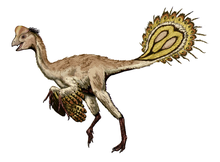
- Nopcsaspondylus
- Normanniasaurus
- Nothronychus
- Notoceratops – nomen dubium
- Notocolossus
- Notohypsilophodon
- Nqwebasaurus
- "Nteregosaurus" – nomen nudum; Janenschia
- "Nurosaurus" – nomen nudum
- Nuthetes – nomen dubium
- Nyasasaurus – possibly a non-dinosaurian dinosauriform
- "Nyororosaurus" – nomen nudum; Dicraeosaurus
O
| Contents: | A B C D E F G H I J K L M N O P Q R S T U V W X Y Z – See also |
|---|
- Ohmdenosaurus
- Ojoceratops - possible junior synonym of Triceratops or Eotriceratops
- Ojoraptorsaurus
- Oligosaurus – junior synonym of Rhabdodon
- Olorotitan
- Omeisaurus
- "Omosaurus" – preoccupied name, now known as Dacentrurus
- Onychosaurus – synonym of Rhabdodon, or a dubious ankylosaurian
- Oohkotokia – possible junior synonym of Scolosaurus
- Opisthocoelicaudia – possible junior synonym of Nemegtosaurus
- Oplosaurus
- "Orcomimus" – nomen nudum
- Orinosaurus – junior synonym (unneeded replacement name) of Orosaurus
- Orkoraptor
- Ornatotholus – junior synonym of Stegoceras
- Ornithodesmus
- "Ornithoides" – nomen nudum; Saurornithoides
- Ornitholestes

- Ornithomerus – junior synonym of Rhabdodon
- Ornithomimoides
- Ornithomimus
- Ornithopsis
- Ornithosuchus – a non-dinosaurian archosaur
- Ornithotarsus – junior synonym of Hadrosaurus
- Orodromeus
- Orosaurus – junior synonym of Euskelosaurus
- Orthogoniosaurus
- Orthomerus
- Oryctodromeus
- "Oshanosaurus" – nomen nudum
- Osmakasaurus[12]
- Ostafrikasaurus
- Othnielia
- Othnielosaurus
- Otogosaurus
- Ouranosaurus
- Overosaurus
- Oviraptor
- "Ovoraptor" – nomen nudum; Velociraptor
- Owenodon
- Oxalaia
- Ozraptor
P
| Contents: | A B C D E F G H I J K L M N O P Q R S T U V W X Y Z – See also |
|---|
- Pachycephalosaurus
- Pachyrhinosaurus
- Pachysauriscus – junior synonym of Plateosaurus
- Pachysaurops – junior synonym of Plateosaurus
- "Pachysaurus" – preoccupied name, now known as Pachysauriscus; junior synonym of Plateosaurus
- Pachyspondylus – probable junior synonym of Massospondylus
- Pachysuchus[13]
- Padillasaurus
- Pakisaurus
- Palaeoctonus – a phytosaur
- Palaeocursornis – an azhdarchoid pterosaur
- "Palaeolimnornis" – nomen nudum; Palaeocursornis, pterodactyloid pterosaur belonging to Azhdarchoidea
- Palaeopteryx – possibly a bird
- Palaeosauriscus – junior synonym of Paleosaurus
- "Palaeosaurus" Riley & Stutchbury, 1836 – preoccupied name, now known as Paleosaurus
- "Palaeosaurus" Fitzinger, 1840 – preoccupied name, now known as Sphenosaurus, a non-dinosaurian procolophonid
- Palaeoscincus
- Paleosaurus – a non-dinosaurian archosaur
- Paludititan
- Paluxysaurus – junior synonym of Sauroposeidon
- Pampadromaeus[14]
- Pamparaptor
- Panamericansaurus
- Panguraptor
- Panoplosaurus
- Panphagia
- Pantydraco

- "Paraiguanodon" – nomen nudum; Bactrosaurus
- Paralititan
- Paranthodon
- Pararhabdodon
- Parasaurolophus
- Pareiasaurus – a pareiasaur
- Parksosaurus
- Paronychodon
- Parrosaurus
- Parvicursor
- Patagonykus
- Patagosaurus
- Pawpawsaurus
- Pectinodon
- Pedopenna
- Pegomastax
- Peishansaurus
- Pekinosaurus – a pseudosuchian; possibly a junior synonym of Revueltosaurus
- Pelecanimimus
- Pellegrinisaurus
- Peloroplites
- Pelorosaurus
- "Peltosaurus" – preoccupied name, now known as Sauropelta
- Penelopognathus
- Pentaceratops
- Petrobrasaurus[15]
- Phaedrolosaurus
- Philovenator
- Phuwiangosaurus
- Phyllodon
- Piatnitzkysaurus
- Picrodon
- Pinacosaurus
- Pisanosaurus
- Pitekunsaurus
- Piveteausaurus
- Planicoxa
- Plateosauravus
- Plateosaurus
- Platyceratops
- Plesiohadros
- Pleurocoelus – possible junior synonym of Astrodon
- Pleuropeltus – junior synonym of Struthiosaurus
- Pneumatoarthrus – a turtle
- Pneumatoraptor
- Podokesaurus
- Poekilopleuron
- Polacanthoides – junior synonym of Hylaeosaurus
- Polacanthus
- Polyodontosaurus – junior synonym of Troodon
- Polyonax
- Ponerosteus
- Poposaurus – a non-dinosaurian archosaur

- Postosuchus – a rauisuchian
- Pradhania
- Prenocephale
- Prenoceratops
- Priconodon
- Priodontognathus
- Proa
- Probrachylophosaurus
- Probactrosaurus
- Proceratops – junior synonym (unneeded replacement name) of Ceratops
- Proceratosaurus
- Procerosaurus von Huene, 1902 – a prolacertiform archosauromorph
- "Procerosaurus" Fritsch, 1905 – preoccupied name, now known as Ponerosteus
- Procheneosaurus – junior synonym of Lambeosaurus
- Procompsognathus
- Prodeinodon
- "Proiguanodon" – nomen nudum; Iguanodon
- Propanoplosaurus
- Proplanicoxa – probable junior synonym of Mantellisaurus
- Prosaurolophus
- Protarchaeopteryx
- Protecovasaurus – a non-dinosaurian archosauriform
- Protiguanodon – junior synonym of Psittacosaurus
- Protoavis – described as a bird, probably a chimera including theropod dinosaur bones
- Protoceratops
- Protognathosaurus
- "Protognathus" – preoccupied name, now known as Protognathosaurus
- Protohadros
- Protorosaurus von Meyer, 1830 – a non-dinosaurian reptile
- "Protorosaurus" Lambe, 1914 – preoccupied name, now known as Chasmosaurus
- "Protrachodon" – nomen nudum; Orthomerus
- "Proyandusaurus" – nomen nudum; Hexinlusaurus.
- Pseudolagosuchus – a non-dinosaurian dinosauromorph
- Psittacosaurus
- Pteropelyx
- Pterospondylus
- Puertasaurus
- Pukyongosaurus
- Pulanesaura
- Pycnonemosaurus
- Pyroraptor
Q
| Contents: | A B C D E F G H I J K L M N O P Q R S T U V W X Y Z – See also |
|---|

- Qantassaurus
- Qianzhousaurus
- Qiaowanlong
- Qijianglong
- Qinlingosaurus
- Qingxiusaurus
- Qiupalong
- Quaesitosaurus
- Quetecsaurus
- Quilmesaurus
R
| Contents: | A B C D E F G H I J K L M N O P Q R S T U V W X Y Z – See also |
|---|
- Rachitrema – a chimera primarily based on ichthyosaur fossils
- Rahiolisaurus
- "Rahona" – preoccupied name, now known as Rahonavis
- Rahonavis – possibly a bird
- Rajasaurus
- Rapator
- Rapetosaurus
- Raptorex
- Ratchasimasaurus
- Rayososaurus
- Razanandrongobe – may be a theropod or crocodylomorph
- Rebbachisaurus
- Regaliceratops
- Regnosaurus
- Revueltosaurus – a pseudosuchian
- Rhabdodon
- Rhadinosaurus – may be non-dinosaurian, possibly crocodilian
- Rhinorex – probable junior synonym of Gryposaurus
- Rhodanosaurus – junior synonym of Struthiosaurus
- Rhoetosaurus
- Rhopalodon – a synapsid
- Riabininohadros
- Richardoestesia

- "Rileya" – preoccupied name, now known as Rileyasuchus
- Rileyasuchus – a phytosaur
- Rinchenia
- Rinconsaurus
- Rioarribasaurus – junior synonym of Coelophysis
- "Riodevasaurus"[16] - nomen nudum; Turiasaurus
- Riojasaurus
- Riojasuchus – a non-dinosaurian archosaur
- Rocasaurus
- "Roccosaurus" – nomen nudum; Melanorosaurus
- Rubeosaurus
- Ruehleia
- Rugops
- Rukwatitan
- Ruyangosaurus
S
| Contents: | A B C D E F G H I J K L M N O P Q R S T U V W X Y Z – See also |
|---|
- Sacisaurus – a silesaurid
- Sahaliyania
- Saichania
- Saldamosaurus
- "Salimosaurus" – nomen nudum, probably Giraffatitan
- Saltasaurus
- Saltopus – probably a non-dinosaurian dinosauromorph
- "Saltriosaurus" – nomen nudum
- "Sanchusaurus" – nomen nudum
- "Sangonghesaurus" – nomen nudum
- Sanjuansaurus
- Sanpasaurus
- Santanaraptor
- Sarahsaurus
- Sarcolestes
- Sarcosaurus
- Saturnalia
- Sauraechinodon – junior synonym of Echinodon
- Saurolophus
- Sauroniops
- Sauropelta
- Saurophaganax
- "Saurophagus" – preoccupied name, now known as Saurophaganax
- Sauroplites
- Sauroposeidon
- Saurornithoides
- Saurornitholestes
- Scansoriopteryx
- Scaphonyx – a rhynchosaur
- Scelidosaurus
- Scipionyx
- Sciurumimus[17]
- Scleromochlus – a non-dinosaurian avemetatarsalian
- Scolosaurus

- Scutellosaurus
- Secernosaurus
- Sefapanosaurus
- Segisaurus
- Segnosaurus
- Seismosaurus – junior synonym of Diplodocus
- Seitaad
- "Selimanosaurus" – nomen nudum; Dicraeosaurus
- Sellacoxa
- Sellosaurus – junior synonym of Plateosaurus
- Serendipaceratops
- Shamosaurus
- Shanag
- Shanshanosaurus – junior synonym of Tarbosaurus
- Shantungosaurus
- Shanxia
- Shanyangosaurus
- Shaochilong
- Shenzhousaurus
- Shidaisaurus
- Shixinggia
- Shuangmiaosaurus
- Shunosaurus
- Shuvosaurus – a rauisuchian
- Shuvuuia
- Siamodon
- Siamodracon
- Siamosaurus
- Siamotyrannus
- Siats
- Sigilmassasaurus
- Silesaurus – a silesaurid
- Siluosaurus
- Silvisaurus
- Similicaudipteryx
- Sinocalliopteryx
- Sinoceratops
- Sinocoelurus
- Sinopeltosaurus
- Sinornithoides
- Sinornithomimus
- Sinornithosaurus
- Sinosauropteryx
- Sinosaurus
- Sinotyrannus
- Sinovenator
- Sinraptor
- Sinusonasus
- Sirindhorna

- Skorpiovenator
- "Smilodon" – preoccupied name, now known as Zanclodon
- Sonidosaurus
- Sonorasaurus
- Sphaerotholus
- Sphenosaurus – a non-dinosaurian reptile
- Sphenospondylus
- Spinophorosaurus
- Spinops
- Spinosaurus
- Spinostropheus
- Spinosuchus – a non-dinosaurian reptile
- Spondylosoma – possibly a rauisuchian
- Squalodon – a cetacean
- Staurikosaurus
- Stegoceras
- Stegopelta
- Stegosaurides
- Stegosaurus
- Stenonychosaurus – junior synonym of Troodon
- Stenopelix
- Stenotholus – junior synonym of Stygimoloch
- Stephanosaurus – junior synonym of Lambeosaurus
- "Stereocephalus" – preoccupied name, now known as Euoplocephalus
- Sterrholophus – junior synonym of Triceratops
- Stokesosaurus
- Stormbergia
- Strenusaurus – junior synonym of Riojasaurus
- Streptospondylus
- Struthiomimus
- Struthiosaurus
- Stygimoloch – possibly a sub-adult Pachycephalosaurus
- Stygivenator – junior synonym of Tyrannosaurus
- Styracosaurus
- Succinodon – fossilized mollusc borings
- Suchomimus
- Suchosaurus – originally described as a crocodile, a spinosaurid
- Suchoprion – a phytosaur
- "Sugiyamasaurus" – nomen nudum

- Sulaimanisaurus
- Supersaurus
- Suuwassea
- Suzhousaurus
- Symphyrophus – junior synonym of Camptosaurus
- Syngonosaurus - junior synonym of Acanthopholis
- "Syntarsus" – preoccupied name, renamed Megapnosaurus which is now a junior synonym of Coelophysis
- Syrmosaurus – junior synonym of Pinacosaurus
- Szechuanosaurus
T
| Contents: | A B C D E F G H I J K L M N O P Q R S T U V W X Y Z – See also |
|---|
- Tachiraptor
- Talarurus
- Talenkauen
- Talos
- Tambatitanis
- Tangvayosaurus
- Tanius
- Tanycolagreus
- Tanystropheus – a prolacertiform archosauromorph
- Tanystrosuchus
- Taohelong
- Tapinocephalus – a therapsid
- Tapuiasaurus[18]
- Tarascosaurus
- Tarbosaurus
- Tarchia
- Tastavinsaurus
- Tatankacephalus
- Tatankaceratops - probable junior synonym of Triceratops
- Tataouinea
- Tatisaurus
- Taveirosaurus
- Tawa
- Tawasaurus - junior synonym of Lufengosaurus
- Tazoudasaurus
- Technosaurus – a silesaurid
- Tecovasaurus – a non-dinosaurian archosauriform
- Tehuelchesaurus
- Teinurosaurus
- "Teleocrater" – nomen nudum; possibly non-dinosaurian
- Telmatosaurus
- "Tenantosaurus" – nomen nudum; Tenontosaurus
- "Tenchisaurus" - nomen nudum; an unpublished museum name for Tianchisaurus
- Tendaguria
- Tenontosaurus
- Teratophoneus
- Teratosaurus – a non-dinosaurian archosaur
- Termatosaurus – a phytosaur
- Tethyshadros
- Tetragonosaurus – junior synonym of Lambeosaurus

- Texacephale
- Texasetes
- Teyuwasu
- Thecocoelurus
- Thecodontosaurus
- Thecospondylus
- Theiophytalia
- Therizinosaurus
- Therosaurus – junior synonym of Iguanodon
- Thescelosaurus
- Thespesius – possibly Edmontosaurus
- "Thotobolosaurus" – nomen nudum
- Tianchisaurus
- "Tianchungosaurus" – nomen nudum; Dianchungosaurus (crocodilian)
- Tianyulong
- Tianyuraptor
- Tianzhenosaurus
- Tichosteus
- Tienshanosaurus
- Timimus
- Titanoceratops
- Titanosaurus Lydekker, 1877
- "Titanosaurus" Marsh, 1877 – preoccupied name, now known as Atlantosaurus
- Tochisaurus
- "Tomodon" – preoccupied name, now known as Diplotomodon
- Tonganosaurus
- "Tonouchisaurus" – nomen nudum
- Torilion – junior synonym of Barilium
- Tornieria
- Torosaurus
- Torvosaurus
- Tototlmimus
- Trachodon
- Traukutitan
- Trialestes – a crocodilian
- "Triassolestes" – preoccupied name, now known as Trialestes
- Tribelesodon – Tanystropheus, a prolacertiform archosauromorph
- Triceratops
- Trigonosaurus
- Trimucrodon
- Trinisaura
- Troodon
- Tsaagan
- Tsagantegia
- Tsintaosaurus
- "Tsuchikurasaurus" – nomen nudum[19]
- Tugulusaurus
- Tuojiangosaurus
- Turanoceratops
- Turiasaurus
- Tylocephale
- Tylosteus – synonym of Pachycephalosaurus
- Tyrannosaurus
- Tyrannotitan
U
| Contents: | A B C D E F G H I J K L M N O P Q R S T U V W X Y Z – See also |
|---|

- Uberabatitan
- Udanoceratops
- Ugrosaurus – junior synonym of Triceratops
- Ugrunaaluk
- Uintasaurus – junior synonym of Camarasaurus
- Ultrasauros – junior synonym of Supersaurus
- Ultrasaurus H. M. Kim, 1983
- "Ultrasaurus" Jensen, 1985 – preoccupied name, renamed Ultrasauros which is now a junior synonym of Supersaurus
- Umarsaurus – nomen nudum; Barsboldia
- Unaysaurus
- Unenlagia
- Unescoceratops
- "Unicerosaurus" – nomen nudum, a fish
- Unquillosaurus
- Urbacodon
- Utahceratops
- Utahraptor
- Uteodon[12]
V
| Contents: | A B C D E F G H I J K L M N O P Q R S T U V W X Y Z – See also |
|---|
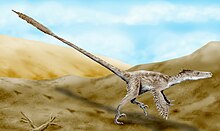
- Vectensia – junior synonym of Polacanthus
- Vectisaurus
- Velafrons
- Velocipes
- Velociraptor
- Velocisaurus
- Venaticosuchus – a non-dinosaurian archosaur
- Venenosaurus
- Veterupristisaurus
- Vitakridrinda
- Vitakrisaurus
- Volkheimeria
- Vulcanodon
W
| Contents: | A B C D E F G H I J K L M N O P Q R S T U V W X Y Z – See also |
|---|
- Wadhurstia – junior synonym of Hypselospinus
- Wakinosaurus
- Walgettosuchus
- "Walkeria" – preoccupied name, now known as Alwalkeria
- "Walkersaurus" – nomen nudum; Duriavenator

- "Wangonisaurus" – nomen nudum, probably Giraffatitan
- Wannanosaurus
- Wellnhoferia – a bird, possible junior synonym of the bird Archaeopteryx
- Wendiceratops
- Willinakaqe[20]
- Wintonotitan
- Wuerhosaurus
- Wulagasaurus
- Wulatelong
- Wyleyia – probably a bird
- "Wyomingraptor" – nomen nudum
X
| Contents: | A B C D E F G H I J K L M N O P Q R S T U V W X Y Z – See also |
|---|

- Xiaotingia
- Xinjiangovenator
- Xinjiangtitan
- Xiongguanlong
- Xixianykus
- Xixiasaurus
- Xixiposaurus
- Xuanhanosaurus
- Xuanhuaceratops
- "Xuanhuasaurus" – nomen nudum; Xuanhuaceratops
- Xuwulong[21]
Y
| Contents: | A B C D E F G H I J K L M N O P Q R S T U V W X Y Z – See also |
|---|
- Yaleosaurus – junior synonym of Anchisaurus
- Yamaceratops
- Yandusaurus
- Yangchuanosaurus

- Yaverlandia
- "Yezosaurus" – nomen nudum; a mosasaur
- Yi
- "Yibinosaurus" – nomen nudum
- Yimenosaurus
- Yingshanosaurus
- Yinlong
- Yixianosaurus
- "Yizhousaurus" – nomen nudum[22]
- Yongjinglong
- "Yuanmouraptor" – nomen nudum
- Yuanmousaurus
- Yueosaurus
- Yulong
- Yunganglong
- Yunnanosaurus
- "Yunxianosaurus" – nomen nudum
- Yurgovuchia
- Yutyrannus
Z
| Contents: | A B C D E F G H I J K L M N O P Q R S T U V W X Y Z – See also |
|---|
- Zalmoxes
- Zanabazar
- Zanclodon – non-dinosaurian
- Zapalasaurus
- Zapsalis
- Zaraapelta
- Zatomus – a non-dinosaurian archosaur
- Zby
- Zephyrosaurus

- Zhanghenglong
- Zhejiangosaurus
- Zhenyuanlong
- Zhongornis
- Zhongyuansaurus
- Zhuchengceratops
- Zhuchengosaurus - junior synonym of Shantungosaurus
- Zhuchengtyrannus
- Ziapelta
- Zigongosaurus
- Zizhongosaurus
- Zuniceratops
- Zuolong
- Zuoyunlong
- Zupaysaurus
See also
- Dinosaur classification
- List of dinosaur ichnogenera
- List of ichthyosaurs
- List of mosasaurs
- List of plesiosaurs
- List of pterosaurs
- List of South American dinosaurs
- List of North American dinosaurs
- List of African dinosaurs
- List of Asian dinosaurs
- List of European dinosaurs
- List of Indian and Madagascan dinosaurs
- List of Australian and Antarctic dinosaurs
- List of commonly used taxonomic affixes
Notes
- Uncited genera names can be attributed to Olshevsky's "Dinosaur Genera List". Dalianraptor is listed by Olshevsky, but omitted from this list, since it has not been described as a non-avian dinosaur in a published source.
- ^ Nesbitt, S.J.; Clarke, J.A.; Turner, A.H.; Norell, M.A. (2011). "A small alvarezsaurid from the eastern Gobi Desert offers insight into evolutionary patterns in the Alvarezsauroidea". Journal of Vertebrate Paleontology. 31 (1): 144–153. doi:10.1080/02724634.2011.540053.
- ^ Taylor, M. (12 February 2005). Re: Raptor Red and Heyday Of The Giants. Dinosaur Mailing List.
- ^ Williams, T. (13 February 2005). Re: Raptor Red and Heyday Of The Giants. Dinosaur Mailing List.
- ^ Tortosa, Thierry; Eric Buffetaut; Nicolas Vialle; Yves Dutour; Eric Turini; Gilles Cheylan (2013). "A new abelisaurid dinosaur from the Late Cretaceous of southern France: Palaeobiogeographical implications". Annales de Paléontologie (In press). doi:10.1016/j.annpal.2013.10.003. Retrieved 13 December 2013.
- ^ Pascal Godefroit, François Escuillié, Yuri L. Bolotsky and Pascaline Lauters (2012). "A New Basal Hadrosauroid Dinosaur from the Upper Cretaceous of Kazakhstan". In Godefroit, P. (eds) (ed.). Bernissart Dinosaurs and Early Cretaceous Terrestrial Ecosystems. Indiana University Press. pp. 335–358.
{{cite book}}:|editor=has generic name (help)CS1 maint: multiple names: authors list (link) - ^ a b c Gregory S. Paul (2012). "Notes on the rising diversity of iguanodont taxa, and iguanodonts named after Darwin, Huxley and evolutionary science". Actas de V Jornadas Internacionales sobre Paleontologia de Dinosaurios y su Entorno, Salas de los Infantes, Burgos. Colectivo de Arqueologico-Paleontologico de Salas de los Infantes (Burgos). pp. 121–131.
- ^ J. I. Ruiz-Omeñaca (2011) Delapparentia turolensis nov. gen et sp., un nuevo dinosaurio iguanodontoideo (Ornithischia: Ornithopoda) en el Cretácico Inferior de Galve. Estudios Geológicos (advance online publication) doi:10.3989/egeol.40276.124[1]
- ^ Jin Liyong, Chen Jun and Pascal Godefroit (2012). "A New Basal Ornithomimosaur (Dinosauria: Theropoda) from the Early Cretaceous Yixian Formation, Northeast China". In Godefroit, P. (eds) (ed.). Bernissart Dinosaurs and Early Cretaceous Terrestrial Ecosystems. Indiana University Press. pp. 467–487.
{{cite book}}:|editor=has generic name (help) - ^ "A New Basal Sauropodomorph (Dinosauria: Saurischia) from Quebrada del Barro Formation (Marayes-El Carrizal Basin), Northwestern Argentina". PLoS ONE. 6 (11): e26964. 2011. doi:10.1371/journal.pone.0026964. PMC 3212523. PMID 22096511.
{{cite journal}}: Unknown parameter|authors=ignored (help)CS1 maint: unflagged free DOI (link) - ^ Prieto-Márquez, A.; Chiappe, L. M.; Joshi, S. H. (2012). Dodson, Peter (ed.). "The lambeosaurine dinosaur Magnapaulia laticaudus from the Late Cretaceous of Baja California, Northwestern Mexico". PLoS ONE. 7 (6): e38207. doi:10.1371/journal.pone.0038207. PMC 3373519. PMID 22719869.
{{cite journal}}: CS1 maint: unflagged free DOI (link) - ^ Henderson (2005). "Nano No More: The death of the pygmy tyrant." In: "The origin, systematics, and paleobiology of Tyrannosauridae", a symposium hosted jointly by Burpee Museum of Natural History and Northern Illinois University.
- ^ a b Andrew T. McDonald (2011). "The taxonomy of species assigned to Camptosaurus (Dinosauria: Ornithopoda)" (PDF). Zootaxa. 2783: 52–68.
- ^ Paul M. Barrett and Xu Xing (2012). "The enigmatic reptile Pachysuchus imperfectus Young, 1951 from the Lower Lufeng Formation (Lower Jurassic) of Yunnan, China" (PDF). Vertebrata PalAsiatica. 50 (2): 151–159.
- ^ Cabreira, Sergio F.; Cesar L. Schultz; Jonathas S. Bittencourt; Marina B. Soares; Daniel C. Fortier; Lúcio R. Silva; Max C. Langer (2011). "New stem-sauropodomorph (Dinosauria, Saurischia) from the Triassic of Brazil". Naturwissenschaften. 98 (12): 1035–40. doi:10.1007/s00114-011-0858-0. PMID 22083251.
- ^ Leonardo S. Filippi, José Ignacio Canudo, Leonardo J. Salgado, Alberto C. Garrido, Rodolfo A. Garcia, Ignacio A. Cerda and Alejandro Otero (in press). "A new sauropod titanosaur from the Plottier Formation (Upper Cretaceous) of Patagonia (Argentina)" (PDF). Geologica Acta. 9 (1): 1–23. doi:10.1344/105.000000???.
{{cite journal}}: Check date values in:|year=(help)CS1 maint: multiple names: authors list (link) CS1 maint: year (link) - ^ Tweet, J (n.d.). "Eusauropoda". Retrieved 31 December 2012.
- ^ Rauhut, O. W. M.; Foth, C.; Tischlinger, H.; Norell, M. A. (2012). "Exceptionally preserved juvenile megalosauroid theropod dinosaur with filamentous integument from the Late Jurassic of Germany". Proceedings of the National Academy of Sciences. 109 (29): 11746–11751. doi:10.1073/pnas.1203238109. PMC 3406838. PMID 22753486.
- ^ Hussam Zaher, Diego Pol, Alberto B. Carvalho, Paulo M. Nascimento, Claudio Riccomini, Peter Larson, Rubén Juarez-Valieri, Ricardo Pires-Domingues, Nelson Jorge da Silva Jr., Diógenes de Almeida Campos (2011). Sereno, Paul (ed.). "A Complete Skull of an Early Cretaceous Sauropod and the Evolution of Advanced Titanosaurians". PLoS ONE. 6 (2): e16663. doi:10.1371/journal.pone.0016663. PMC 3034730. PMID 21326881.
{{cite journal}}: CS1 maint: multiple names: authors list (link) CS1 maint: unflagged free DOI (link) - ^ "Japanese theropod nomen nudum extravaganza" Dinosaur Mailing List.
- ^ Rubén D. Juárez Valieri, José A. Haro, Lucas E. Fiorelli and Jorge O. Calvo (2010). "A new hadrosauroid (Dinosauria: Ornithopoda) from the Allen Formation (Late Cretaceous) of Patagonia, Argentina" (PDF). Revista del Museo Argentino de Ciencias Naturales n.s. 11 (2): 217–231.
{{cite journal}}: CS1 maint: multiple names: authors list (link) - ^ You Hailu, Li Daqing and Liu Weichang (2011). "A New Hadrosauriform Dinosaur from the Early Cretaceous of Gansu Province, China". Acta Geologica Sinica. 85 (1): 51–57. doi:10.1111/j.1755-6724.2011.00377.x.
- ^ Sankar Chatterjee, Wang, T., Pan, S.G., Dong, Z., Wu, X.C., and Paul Upchurch (2010). "A complete skeleton of a basal Sauropod Dinosaur from the early Jurassic of China and the origin of Sauropoda". Geological Society of America Abstracts with Programs. 42 (5): 26.
{{cite journal}}: Italic or bold markup not allowed in:|journal=(help)CS1 maint: multiple names: authors list (link)
References
- Lambert, D. (1993). "A to Z of Dinosaurs" In: The Ultimate Dinosaur Book. Dorling Kindersley, 192 pp. ISBN 0-7513-0047-0
- Olshevsky, G. (1995 onwards). Dinosaur Genera List. Retrieved July 30, 2013.
- Walters, M. & J. Paker (1995). Dictionary of Prehistoric Life. Claremont Books. ISBN 1-85471-648-4.
- Weishampel, D.B., P. Dodson & H. Osmólska (eds.) (2004). The Dinosauria, Second Edition. University of California Press, 861 pp. ISBN 0-520-24209-2.
